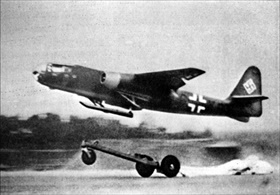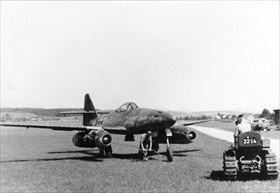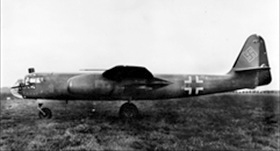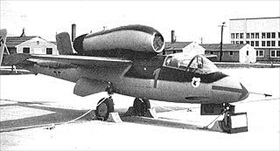ARADO AR 234 BLITZ FLIGHT TESTING BEGINS
Rheine Airfield, Lower Saxony, Germany • June 15, 1943
On this date in 1943 the world’s first jet-powered bomber, the Arado Ar 234 Blitz (English, Lightning), made its appearance in the skies over Northwestern Germany. The flight of this all-metal, single-seat, twin-jet prototype came 11 months after the first flight test of a fully configured Messerschmitt Me 262 Swallow (Schwalbe) fighter/interceptor. Although construction of Arado’s revolutionary prototype began in the spring of 1941, the maiden flight of the Blitz was delayed 2 years due to Junkers Aircraft Company working out reliability kinks in its Jumo 004 axial-flow turbojet engine: both Arado Flugzeugwerke and Messerschmitt relied on the same manufacturer for their powerplant.
The Me 262 entered operational service in April 1944, this time behind schedule because Adolf Hitler demanded multiple versions of the jet: fighter, fighter-bomber, night-fighter, light bomber, and reconnaissance versions were among its many variants. The Ar 234 first saw service 3 months later in just 2 versions: bomber and unarmed reconnaissance plane. Commander, Army Group B in France, Field Marshal Erwin Rommel, after meeting with Hitler and other senior generals of the Western Theater in mid-March 1944, took heart that progress was finally being made in the production of the new high-speed jets under the direction of Armaments Minister Albert (pronounced “spare”).
To reduce aircraft weight and increase air speed the first prototypes of the Ar 234A used a problematic 1,400 lb/635 kg, 3‑wheeled takeoff dolly and landing skids, both falling out of favor in the B‑series machine. Even after retractable tricycle landing gear was built into the slightly widen Ar 234B’s fuselage, air speeds topped out at 461 mph/742 km/hr when fully loaded (21,605 lb/9,800 kg), which was roughly 26 mph/42 km/hr slower that the piston-driven North American P‑51H Mustang, the fastest (at 487 mph/784 km/hr), most sophisticated fighter in the Allied air armory. The Blitz flew at a service ceiling of 32,810 ft./10,000 m and had a range of 1,013 miles/1,630 km.
The reconnaissance (German, Aufklaerer) version of the Ar 234 buzzed Normandy’s beaches in July 1944. Other Blitz formations conducted aerial reconnaissance over Northern Europe, Italy, and Great Britain. The bomber version saw combat with KG (Kampfgeschwader; English, Battle Wing) 76 in January 1945, the only Blitz bomber wing. Flying from Rheine and Achmer airbases in Lower Saxony, KG 76 participated in the Battle of the Bulge (aka Ardennes Offensive, December 16, 1944, to January 25, 1945) in a close air support role. Able to carry a 1,500–2,000 kg/3,310–4,409 lb bomb load externally (fuel completely filled the fuselage), KG 76 bombers made many daring and accurate air strikes, the last against the Red Army near the German capital, Berlin, on May 1, 1945.
By the end of the war just 224 of the 2 versions of the Arado Ar 234 were produced, and then only a small proportion of these aircraft was ever accepted into service. Much of the blame for this can be attributed to a slowdown in industrial activity and shortages of skilled pilots, petroleum products, service personnel, and replacement parts; for example, the Jumo 004B turbojet engine service life was only 10–25 hours before the fan blades, which were made from low-grade materials due to mineral shortages and couldn’t resist heat the way they should, had to be changed out. Very few of the lighter-weight BMW 003A‑1 replacement engines were ever installed, and when they were, they went into the 4‑engine V6 and V8 test aircraft, which offered modest performance increases over the two-engine models. Despite the Blitz’s limitations, the technologically advanced aircraft was of immense interest to the Allies. Intact Ar 234s captured after the war went to Britain and the U.S. and underwent rigorous examination. Visitors to the Smithsonian National Air and Space Museum’s Udvar-Hazy Center in Chantilly, Virginia, can view a restored Ar 234B that was captured in Norway in May 1945.
Hitler’s Jet-Powered Wonder Weapons: Too Few, Too Late to Matter
 |  |
Left: An early version of the Arado Ar 234 jet bomber is assisted by an auxiliary 3‑wheeled dolly during takeoff. The dolly detached from the fuselage as the plane became airborne and came to a stop with the aid of a parachute. Note the retractable landing skids that worked well on a grassy surface—if they extended correctly as the plane approached the runway, which didn’t always happen. Moreover, it was impossible for the jet to taxi on skids, thus necessitating a crane to move the airplane off the tarmac or grass. This issue, plus the potential for jettisoned dollies to clutter takeoff strips during mass operations, sent Arado designers back to the drawing boards.
![]()
Right: The twin-engine Messerschmitt Me 262 Schwalbe was the world’s first operational jet-powered fighter aircraft. It was used in a variety of roles, including light bomber or fighter-bomber in a version known as Sturmvogel (Stormbird), reconnaissance jet, and even experimental night fighter with nose-mounted radar. Despite round-the-clock bombing of German population and industrial centers during the final 12 months of the war, Messerschmitt was able to build roughly 1,430 Me 262s. No more than 200 Me 262s were operational at one time, meaning their small numbers were incapable of influencing the Allied air campaign against Nazi Germany. Armed with no fewer than 4 formidable 30 mm cannon mounted in the nose and several sets of wing-mounted air-to-air rockets, Me 262s destroyed some 150 Allied planes (Me 262 pilots claimed a total of 542 Allied kills), among them their first B‑17 Flying Fortress on August 15, 1944, but the Allies destroyed about 100 Me 262s in the air. In February and March 1945, Allied planes destroyed approximately 60 Me 262s in ground attacks.
 |  |
Left: Photographed at an airfield in Germany, this Arado Ar 234 V13 is representative of the 13th prototype of the aircraft and the variant that set the production standard for the twin-engine jet. Slightly faster but less famous than the Me 262, the Arado Ar 234 Blitz was the world’s first operational jet-powered reconnaissance/bomber. Produced in very limited numbers (total production was 224 in all versions), the Ar 234 was used almost entirely in a reconnaissance role, but in its few uses as a bomber it proved to be nearly impossible to intercept.
![]()
Right: A captured Heinkel He 162 Volksjaeger (People’s Fighter) parked at Freeman Field, Indiana, 1945. Made primarily of wood (metals were in short supply), the twin-tailboom He 162 was a sleek single-engine, jet-powered fighter aircraft using a BMW 003E axial-flow turbojet powerplant. At maximum speed (553 mph, 890 km/hr) at sea level, the lightweight fighter was the fastest of the first-generation World War II jets. First flight of the He 162 occurred on December 6, 1944, just over 12 weeks after design requirements were issued by the German Ministry of Aviation (Reichsluftfahrtministerium). It was armed with a pair of 20mm cannon. The Volksjaeger drew first blood in mid-April 1945 but lost 10 aircraft and 10 pilots to operational losses, not to the enemy. By war’s end on May 8, 1945, 120 He 162s had been delivered to the Luftwaffe. A further 200 had been completed and were awaiting collection, flight-testing, or sat on airfields awaiting fuel that never arrived. About 600 more were in various stages of production.
Arado Ar 234 Blitz: The World’s First Jet Bomber
![]()

 History buffs, there is good news! The Daily Chronicles of World War II is now available as an ebook for $4.99 on Amazon.com. Containing a year’s worth of dated entries from this website, the ebook brings the story of this tumultuous era to life in a compelling, authoritative, and succinct manner. Featuring inventive navigation aids, the ebook enables readers to instantly move forward or backward by month and date to different dated entries. Simple and elegant! Click
History buffs, there is good news! The Daily Chronicles of World War II is now available as an ebook for $4.99 on Amazon.com. Containing a year’s worth of dated entries from this website, the ebook brings the story of this tumultuous era to life in a compelling, authoritative, and succinct manner. Featuring inventive navigation aids, the ebook enables readers to instantly move forward or backward by month and date to different dated entries. Simple and elegant! Click 











